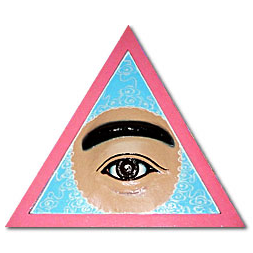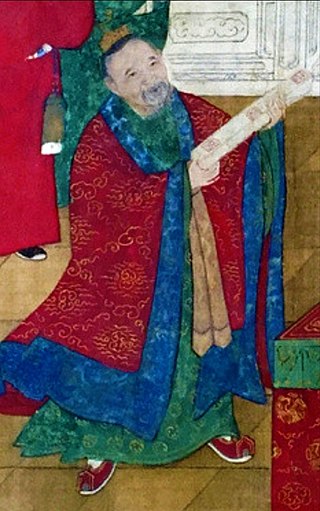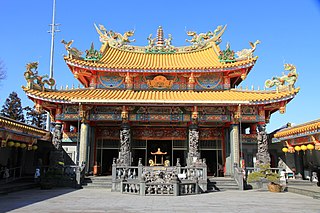
A priest is a religious leader authorized to perform the sacred rituals of a religion, especially as a mediatory agent between humans and one or more deities. They also have the authority or power to administer religious rites; in particular, rites of sacrifice to, and propitiation of, a deity or deities. Their office or position is the 'priesthood', a term which also may apply to such persons collectively. A priest may have the duty to hear confessions periodically, give marriage counseling, provide prenuptial counseling, give spiritual direction, teach catechism, or visit those confined indoors, such as the sick in hospitals and nursing homes.

Taoism or Daoism refers to a set of Chinese traditions and religions which emphasize living in harmony with the Dao. The Dao is generally defined as the source of everything and the ultimate principle underlying reality. The Daodejing and the Zhuangzi are widely considered key Daoist texts.

Clergy are formal leaders within established religions. Their roles and functions vary in different religious traditions, but usually involve presiding over specific rituals and teaching their religion's doctrines and practices. Some of the terms used for individual clergy are clergyman, clergywoman, clergyperson, churchman, ecclesiastic, and cleric, while clerk in holy orders has a long history but is rarely used.

Caodaism is a monotheistic syncretic new religious movement officially established in the city of Tây Ninh in southern Vietnam in 1926. The full name of the religion is Đại Đạo Tam Kỳ Phổ Độ.
Clerical celibacy is the requirement in certain religions that some or all members of the clergy be unmarried. Clerical celibacy also requires abstention from deliberately indulging in sexual thoughts and behavior outside of marriage, because these impulses are regarded as sinful.

The People's Republic of China is officially an atheist state, but the government formally recognizes five religions: Buddhism, Taoism, Christianity, and Islam. In the early 21st century, there has been increasing official recognition of Confucianism and Chinese folk religion as part of China's cultural inheritance. Chinese civilization has historically long been a cradle and host to a variety of the most enduring religio-philosophical traditions of the world. Confucianism and Taoism (Daoism), later joined by Buddhism, constitute the "three teachings" that have shaped Chinese culture. There are no clear boundaries between these intertwined religious systems, which do not claim to be exclusive, and elements of each enrich popular or folk religion. The emperors of China claimed the Mandate of Heaven and participated in Chinese religious practices. In the early 20th century, reform-minded officials and intellectuals attacked all religions as "superstitious"; since 1949, China has been governed by the CCP, a Marxist–Leninist atheist institution that prohibits party members from practicing religion while in office. In the culmination of a series of atheistic and anti-religious campaigns already underway since the late 19th century, the Cultural Revolution against old habits, ideas, customs, and culture, lasting from 1966 to 1976, destroyed or forced them underground. Under subsequent leaders, religious organisations have been given more autonomy.

Chinese folk religion, also known as Chinese popular religion comprehends a range of traditional religious practices of Han Chinese, including the Chinese diaspora. Vivienne Wee described it as "an empty bowl, which can variously be filled with the contents of institutionalised religions such as Buddhism, Taoism, Confucianism and Chinese syncretic religions”. This includes the veneration of shen (spirits) and ancestors, exorcism of demonic forces, and a belief in the rational order of nature, balance in the universe and reality that can be influenced by human beings and their rulers, as well as spirits and gods. Worship is devoted to gods and immortals, who can be deities of places or natural phenomena, of human behaviour, or founders of family lineages. Stories of these gods are collected into the body of Chinese mythology. By the Song dynasty (960-1279), these practices had been blended with Buddhist doctrines and Taoist teachings to form the popular religious system which has lasted in many ways until the present day. The present day government of mainland China, like the imperial dynasties, tolerates popular religious organizations if they bolster social stability but suppresses or persecutes those that they fear would undermine it.

A daoshi, translated as Taoist priest, Taoist monk, or Taoist professional is a priest in Taoism. The courtesy title of a senior daoshi is daozhang, and a highly accomplished and revered daoshi is often called a zhenren.

Religion in Taiwan is characterised by a diversity of religious beliefs and practices, predominantly those pertaining to the continued preservation of the ancient Chinese culture and religion. Freedom of religion is inscribed in the constitution of the Republic of China (Taiwan), and ranks high at 9.2 on the Freedom Scale in 2018 according to the World Bank. The majority of Taiwanese people practice a combination of Buddhism and Taoism often with a Confucian worldview, which is collectively termed as Chinese folk religion.
The Orthodox Church in Italy, also called Chiesa Vecchio-Cattolica in Italia or Old Catholic Church in Italy, is an Old Catholic denomination.

Eastern Orthodoxy in Italy refers to adherents, religious communities, institutions and organizations of Eastern Orthodox Christianity in Italy. In 2014, there were 14 distinctive Eastern Orthodox jurisdictions on the territory of Italy, some of them belonging to canonical Eastern Orthodox churches, while others are classified as independent (noncanonical). First session of the Council of Canonical Orthodox Bishops in Italy was held in 2009.
Antonio De Rosso was an Italian priest and Christian leader who successively belonged to various Christian denominations. After initial priestly service in the Catholic Church, he changed several affiliations. Eventually, he became Eastern Orthodox bishop (1986), founder of the Orthodox Church in Italy (1991), Metropolitan of Ravenna and Italy (1997-2009), and Archbishop of L'Aquila (2009). He was associated with various independent (noncanonical) jurisdictions. Main goal of his religious activity was to create a national church in Italy.
The history ofTaoism stretches throughout Chinese history. Originating in prehistoric China, it has exerted a powerful influence over Chinese culture throughout the ages. Taoism evolved in response to changing times, with its doctrine and associated practices being revised and refined. The acceptance of Taoism by the ruling class has waxed and waned, alternately enjoying periods of favor and rejection. Most recently, Taoism has emerged from a period of suppression and is undergoing a revival in China.

Taoism is believed to be the inspiration for spiritual concepts in Japanese culture. Taoism is similar to Shinto in that it also started as an indigenous religion in China, although it is more hermetic than shamanistic. Taoism's influence can be seen throughout the culture but to a lesser extent than Confucianism.
Yao folk religion is the ethnic religion of the Yao people, a non-Sinitic ethnic group who reside in the Guangxi, Hunan and surrounding provinces of China. Their religion has been profoundly intermingled with Taoism since the 13th century, so much that it is frequently defined as Yao Taoism. In the 1980s it was found that the Yao clearly identified with the Chinese-language Taoist theological literature, seen as a prestigious statute of culture.

Chinese ritual mastery traditions, also referred to as ritual teachings, or Folk Taoism, or also Red Taoism, constitute a large group of Chinese orders of ritual officers who operate within the Chinese folk religion but outside the institutions of official Taoism. The "masters of rites", the fashi (法師), are also known in east China as hongtou daoshi (紅頭道士), meaning "redhead" or "redhat" daoshi, contrasting with the wutou daoshi (烏頭道士), "blackhead" or "blackhat" priests, of Zhengyi Taoism who were historically ordained by the Celestial Master.

The roles of women in Taoism have differed from the traditional patriarchy over women in ancient and imperial China. Chinese women had special importance in some Taoist schools that recognized their transcendental abilities to communicate with deities, who frequently granted women with revealed texts and scriptures. Women first came to prominence in the Highest Clarity School, which was founded in the 4th century by a woman, Wei Huacun. The Tang dynasty (618–907) was a highpoint for the importance of Daoist women, when one-third of the Shangqing clergy were women, including many aristocratic Taoist nuns. The number of Taoist women decreased until the 12th century when the Complete Perfection School, which ordained Sun Bu'er as the only woman among its original disciples, put women in positions of power. In the 18th and 19th centuries, women Taoists practiced and discussed nüdan, involving gender-specific practices of breath meditation and visualization. Furthermore, Taoist divinities and cults have long traditions in China, for example, the Queen Mother of the West, the patron of xian immortality, He Xiangu, one of the Eight Immortals, and Mazu, the protectress of sailors and fishermen.
Oriental Orthodoxy in Italy refers to adherents, religious communities, institutions and organizations of Oriental Orthodox Christianity in Italy. There are several distinctive Oriental Orthodox ecclesiastical jurisdictions on the territory of Italy, main of them being:

Daojiao fushi, also known as Taoist clothing, are religious clothing and adornment worn by devotees and practitioners of Taoism, an indigenous religion and life philosophy in China. Chinese culture attaches great importance to "cap and gown" are seen as important signs of levels of etiquettes; it is also a visible marker of the Taoist identity. Taoist ritual garments (sometimes referred as daoyi are forms of ritual clothing. These clothing worn by the Taoist priests are inherited from the Han Chinese traditional clothing and holds clear Taoist cultural meaning. When performing rituals and important rituals, Taoist priests wear ceremonial attires which appear to be aligned with elements of Chinese cosmology; these ceremonial attires are therefore strong spiritual intermediaries acting on the part of the Taoist devotees community. Different forms of clothing will be worn by Taoist priests in accordance to ritual types and obvious distinctions are found in the attire of Taoist priests based on their different positions to the altar. There were also codes which would stipulate the appropriate Taoist attire to be worn during both ritual performance and when being off duty.











